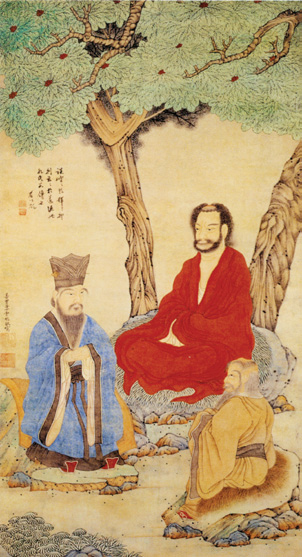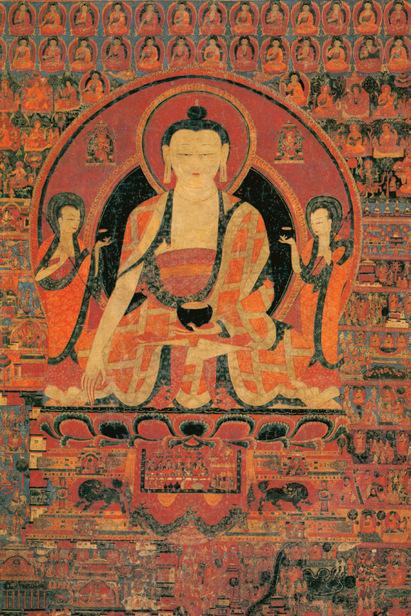An Illustrated Outline of Buddhism: The Essentials of Buddhist Spirituality (7 page)
Read An Illustrated Outline of Buddhism: The Essentials of Buddhist Spirituality Online
Authors: William Stoddart,Joseph A. Fitzgerald
Tags: #Philosophy

9
(4) Buddhism Amongst the World Religions
Before turning our attention to the internal features of Buddhism, it is
important to know how to situate it amongst the religions of the world.
The great religions fall into three fundamental categories: the Hyper-
borean shamanisms (comprising Confucianism, Taoism, and Shinto),
the Aryan mythologies (comprising Hinduism, Buddhism, and the re-
ligion of Ancient Greece and Rome), and the Semitic monotheisms
(comprising Judaism, Christianity, and Islam).
In terms of this classification, Buddhism (as an “Aryan mythol-
ogy”) fal s in a different category from the religion best known to
Westerners, namely Christianity. However, from another point of view,
it can be said that the central role played by the person of the Bud-
dha in Buddhism is analogous to the central role played by Christ in
Christianity. This means that Buddhism can be classified, along with
Hinduism and Christianity (and in contradistinction from Judaism
and Islam) as “incarnationist”. An important concomitant of incarna-
tionism is iconography. In the incarnationist religions, iconography
plays an essential sacramental role. Whereas Judaism and Islam are
“iconoclastic” or “aniconic”, Hinduism, Buddhism, and Christianity
are “iconodulic”. (See p. 23.)
It can also be said that, notwithstanding each religion being an
original and distinct revelation in its own right, Buddhism emerged
from the world of Hinduism, rather as Christianity emerged from the
world of Judaism.
Furthermore, Buddhism (especial y in its
Hīnayāna
or
Theravāda
form) is more or less unique in espousing the point of view that “Ul-
timate Reality” is a Supreme State, rather than a Supreme Being. As
mentioned on p. 1, however, this is, on the one hand, a question of
point of view, and on the other, a question of emphasis, as the “theistic”
perspective is not only prominent in
Mahāyāna
Buddhism, but also by
no means entirely lacking in
Theravāda
Buddhism.
Final y, it should be mentioned that Buddhism, like Christian-
ity and Islam, is a “universal” religion, willingly accepting converts
amongst “all nations”, whereas Hinduism and Judaism are restricted
to virtual y one people. In general terms (and remembering that there
are certain exceptions), one must be born a Hindu or a Jew, whereas
anyone can become a Buddhist, Christian, or Muslim.
The basic classification of the religions referred to in the first para-
graph is given in diagrammatic form on the following page.

10
An Illustrated Outline of Buddhism
Classifififification of the Religions
I. The Hyperborean Shamanisms
Taoism
Confucianism
Shinto
Siberian Shamanism
American Indian
Religion
Bön (the pre-Buddhist Religion of Tibet)
II. The Aryan Mythologies
Hinduism
Buddhism
Greco-Roman Religion*
Ancient Germano-Celtic Religion*
Jainism
Zoroastrianism (Parsiism)
*extinct
III. The Semitic Monotheisms
Judaism
Christianity
Islam



Buddhism Amongst the World Religions
11
China’s Three Messengers:
(
left
) Confucius (551-479 B.C.), (
right
) Lao Tzu (604-531 B.C.),
and (
center
) the Buddha (563-483 B.C.)
It is compassion that constitutes the very heart of the Buddha.
Hōnen





13
(5) Life of the Buddha, Origin of Buddhism
The religion of Buddhism derives from the one who was called the
Buddha
(Sanskrit for “Enlightened” or “Awakened”). His family name
was Gautama, and his given name was Siddhārtha. Siddhārtha Gau-
tama was born about 563 B.C., in the Lumbinī Grove near Kapilavas-
tu, in what is now Nepal. His father, Shuddhōdana, was raja of the
Aryan Shākya tribe. His mother, Māyā, was the daughter of the raja
of the neighboring Koliyan tribe. Their families belonged to the Hin-
du
kshatriya
caste (i.e. the royal, aristocratic, or “warrior” caste). The
dormition of Queen Māyā took place seven days after she gave birth:
“having beheld the glory of her new-born child, she could not sustain
the joy he brought her, and, so as not to die of it, she ascended into
Heaven” (The
Buddha-Charita
of Ashvaghosha, II, 18).
When Siddhārtha Gautama was sixteen years old, he was mar-
ried to his cousin Yashodharā. Gautama lived happily with his wife in
princely luxury, free from the knowledge of care and want. After ten
years of marriage, they had a son who was named Rāhula.
Siddhārtha Gautama’s father had ordered that, whenever he rode
out in his chariot from the palace into the city, no aged, no sick, and
no funeral procession should be in sight—only young and beautiful
